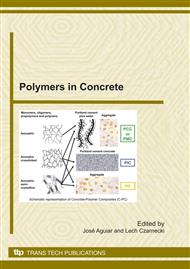[1]
L. Czarnecki, L. Wolff: Defects and damage – electric methods. Industrial Floors, RILEM TC 184-IFE: State-of-the-Art Report, Chapter 3 (2006).
Google Scholar
[2]
H. Schorn, S. Gieler-Breßmer, M. Raupach:. Repair. Industrial Floors, RILEM TC 184-IFE: State-of-the-Art Report, Chapter 5 (2006).
Google Scholar
[3]
W. Wu, T. Chen, W. Zang, R. Chen: Study of the causes of crack in concrete pavement of air-field. RILEM Proceedings PRO 32, Advances in concrete and structures, ICACS 2003, Xuzhou, (2003).
Google Scholar
[4]
M.F.M. Zain, H.B. Mahmud, A. Ilham, M. Faizal: Prediction of splitting tensile strength of high-performance concrete. Cement and Concrete Research 32 (2002) 1251–1258.
DOI: 10.1016/s0008-8846(02)00768-8
Google Scholar
[5]
T.F. Fwa, (ed. ): Handbook of highway engineering. CRC Press, Taylor & Francis Group (2006).
Google Scholar
[6]
J.W. Ju, Y. Zhang: Axisymmetric thermomechanical constitutive and damage modeling for airfield concrete pavement under transient high temperature. Mechanics of Materials 29 (1998) 307-323.
DOI: 10.1016/s0167-6636(98)00028-3
Google Scholar
[7]
A. Kwiecień: Damages of airfields pavements made of concrete (in Polish). Proceedings of XXIV Conference Structural Failures 2009, p.481 – 488, Międzyzdroje.
Google Scholar
[8]
A. Kwiecień, B. Zając, W. Czyczuła, D. Kudła: Analysis of work of cracked concrete pavements basing on investigations of airfield slabs repaired using of a polymer joint (in Polish). Przegląd Komunikacyjny 4/2008, Wyd. SITK, p.29 – 40.
Google Scholar
[9]
P. Cognard: Technical Characteristics and Testing Methods for Adhesives and Sealants. Adhesives and Sealants Basic Concepts and High Tech Bonding Vol. 1, Elsevier (2005).
DOI: 10.1016/s1874-5695(02)80003-3
Google Scholar
[10]
A. Kwiecień, B. Zając, R. Jankowski: Static and dynamic properties of a flexible joint working in cracked historical masonries. Proceedings of Structural Analysis of Historical Constructions VI, Bath, (2008).
DOI: 10.1201/9781439828229.ch106
Google Scholar
[11]
A. Kwiecień, B. Zając: Dynamic response of the cracked masonry building repaired with the Flexible Joint Method – an innovative earthquake protection. Proceedings of 7th European Conference on Structural Dynamics EURODYN'2008, Southampton, (2008).
Google Scholar
[12]
A. Kwiecień: New repair method of cracked concrete airfield surfaces using of polymer joints. 13th Int. Congress on Polymers in Concrete ICPIC 2010, p.657 – 664.
Google Scholar
[13]
A. Kwiecień: Conception of the use of polymer flexible joint in bridges (in Polish). Inżynieria i Budownictwo, No. 5/2009, p.268 – 272.
Google Scholar
[14]
A. Kwiecień: Polymer flexible joints – an innovative repair system protecting cracked masonries against stress concentrations. Proceedings of Protection of Historical Buildings, PROHITECH 09, Mazzolani (ed), Taylor & Francis Group, Vol. 2, pp.1033-1038, London, (2009).
Google Scholar
[15]
Z. Su: Microstructure of polymer-cement concrete. Delft University Press, (1995).
Google Scholar
[16]
A. Kwiecień, M. Gruszczyński, B. Zając: Tests of flexible polymer joints repairing of polymer modified concretes. 13th Int. Congress on Polymers in Concrete ICPIC 2010, p.559 – 566.
DOI: 10.4028/www.scientific.net/kem.466.225
Google Scholar
[17]
Z. Su, J.M. Bijen, J.A. Larbi: Influence of polymer modification on the hydration of portland cement. Cement Concrete Research 21/1991, pp.535-544.
DOI: 10.1016/0008-8846(91)90103-o
Google Scholar
[18]
S. Okba, A. El-Dieb, M. Reda: Investigations of the sulphate resistance of polymer-modified mortar. 10th Int. Congress on Polymers in Concrete, Hawaii, (2001).
Google Scholar
[19]
S. Schwarz: Research of structures of polymer-modified mortars. 4th Int. Congress on Polymers in Concrete, Darmstadt, (1984).
Google Scholar
[20]
S. Popovics: Polymers for modification of P.C. concrete in USA. 7th Int. Congress on Polymers in Concrete, Moscow, (1992).
Google Scholar
[21]
Z. Nowak, 2007. Constitutive modeling and parameter identification for rubber-like materials. Engineering Transactions, vol. 55, No. 4.
Google Scholar


